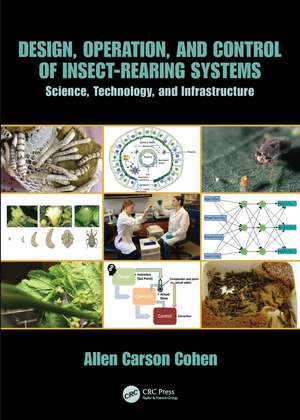Design, Operation, and Control of Insect-Rearing Systems: Science, Technology, and Infrastructure
Autor Allen Carson Cohenen Limba Engleză Hardback – 25 aug 2021
1) the rearing systems, per se
2) personnel
3) education of rearing personnel
4) communication of procedures
5) an in-depth look at silkworm rearing
5) facilities where rearing is conducted, and
6) funding for all these components.
Insect rearing serves a wide array of purposes, including research, pest control by sterile insect technique and biological control, production of insects as food for other animals, conservation, education, and even far-reaching technology where insects are used to produce products such as pharmaceutical materials and strong, multipurpose textiles.
This book surveys and analyzes insect rearing from a scientific and technology-based approach. At its foundation, this approach assumes that rearing systems are complex interactions of components that can be understood and controlled by using a mechanistic approach. Author Allen Carson Cohen explains the infrastructure of rearing systems, their current status and character, and what kind of changes can be made to improve the field of insect rearing. Two Appendices republish out-of-print monographs that provide fascinating historical context to the development of the insect-rearing systems we have today.
Preț: 1003.64 lei
Preț vechi: 1376.37 lei
-27% Nou
Puncte Express: 1505
Preț estimativ în valută:
192.11€ • 208.74$ • 161.47£
192.11€ • 208.74$ • 161.47£
Carte tipărită la comandă
Livrare economică 21 aprilie-05 mai
Preluare comenzi: 021 569.72.76
Specificații
ISBN-13: 9781138571259
ISBN-10: 1138571253
Pagini: 420
Ilustrații: 720
Dimensiuni: 210 x 280 mm
Greutate: 1.38 kg
Ediția:1
Editura: CRC Press
Colecția CRC Press
ISBN-10: 1138571253
Pagini: 420
Ilustrații: 720
Dimensiuni: 210 x 280 mm
Greutate: 1.38 kg
Ediția:1
Editura: CRC Press
Colecția CRC Press
Public țintă
Professional Practice & DevelopmentCuprins
Approaches to Developing Rearing Systems, Creating an Algorithm for Developing or Problem-Solving Rearing Systems, Heuristics, and Reliable, Reproduceable Insect Production. Who Is Who in Insect Rearing?. Design and Operation of Insect Rearing Systems: Science, Technology, and InfrastructureSilkworm Rearing Systems. "Case Study of the USDA, ARS R. T. Gast BCMRRU:Boll Weevil and Lepidoptera Mass-Rearing". Rearing Systems as Ecological Niches or N-Dimensional Hypervolumes. Designing Error (Variability) Reduction in Rearing Systems: Reducing Uncertainty. Building a Process Control System. Tutorials on Using Design of Experiments with SAS, JMP Protocols. Relationships between Fitness, Quality Control, Health, Homeostasis, and Stress. Publishing Rearing Papers. Rearing Education: The Pathway to Improving Rearing Science and Technology. Future of Insect Rearing. Research Integrity in Insect Rearing Studies. Appendix 1. Appendix 2. Appendix 3. Appendix 4
Notă biografică
Allen Carson Cohen completed his high school education in Chicago, Illinois and went to university in California for a BA and MA in English and a teaching credential. He later returned to college for an MA in biology, specializing in the physiological ecology of rattlesnakes. He completed his PhD in entomology at the University of California, Riverside (1978). He has served for seven years as editor for insect diets, insect rearing, and insect feeding biology for the Journal of Insect Science and serves as a mentor for students, researchers, and professionals in diet and rearing science and technology. He holds six U.S. patents, has published more than 125 refereed papers, and has received several technology transfer awards for his work on insect diets. He is currently research professor and coordinator of the Insect Rearing Education and Research Program at North Carolina State University, where he teaches online and in-person courses on insect rearing and conducts research on developing and improving insect rearing systems.
Descriere
This book surveys and analyzes insect rearing from a scientific and technology-based approach. At its foundation, this approach assumes that rearing systems are complex interactions of components that can be understood and controlled by using a mechanistic approach.
